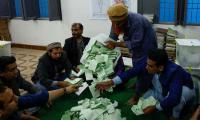The Millennium Development Goals (MDGs) – an idea of the UN – proved to be a historical moment for international development in 2000. Once the proposition received a positive response, 189 countries signed a pact – The Millennium Declaration. In 2000, the MDGs were implemented in Pakistan to address the issue of extreme poverty and to provide the basic human rights of health, education and security.
While the country made some progress in the health sector as shown by its health indicators, Pakistan was still lagging far behind other countries that had similar levels of income or had started with similar set targets. In order to further improve its service delivery in key areas of healthcare, the government implemented special programmes like the Lady Health Worker Programme (LHW), the Expanded Programme on Immunisation (EPI), the National Maternal, Neonatal and Child Health Programme (MNCH), Programme for HIV/AIDS Control and Programme for Malaria Control. However, the country has failed to meet its health-related MDGs.
The health sector and reforms in Pakistan have suffered many snags due to changing administrative mechanisms and financial arrangements made during the devolution period. The process of reforms had started from the city district government plan of 2001 but once the devolution process started in 2010, the arena of health was partially handed over to the provincial government in 2011.
In the initial post-devolution phase, the provinces did not have any interprovincial coordination offices which posed a real challenge for the implementation of the reforms. Since the funding was kept within the ambit of the federal government till 2014, there were financial constraints for vertical programmes like MNCH, LHW.
Moreover, no institution claimed ownership of these programmes. Each federating unit had to devise its own policies in the absence of any benchmark of standards and there was no system of operation after the implementation of the policies. The entire situation resulted in lack of clarity over job responsibilities at different levels and eventually failed to achieve the set targets of the MDGs. The shifting role of the organisations in managing the strategies and plans appeared to be a vital factor towards the poor progress of the MDGs.
Pakistan’s spending on the health sector – far less than the WHO’s recommended figure of $34 per capita for low and middle income countries – was another factor that caused the failure of the MDGs. This amount is insufficient not only according to the standards of developing countries, but also when compared to the standards of poor South Asian countries. Pakistan’s health-related spending (the total expenditure on health as a percentage of the GDP is 2.8 percent) is the lowest among all South Asian countries, including Nepal and Bhutan.
According to the World Bank, the annual population growth rate in Pakistan is 2.1 percent. This rapid rise in population has undermined most of the health development initiatives because the plans and resources set forth are on the basis of an estimated number of people and do not take into account the resource-to-population growth ratio. Moreover, limited resources, coupled with the fast and haphazard pace of urbanisation and the subsequent environmental degradation has created difficulties in the development of planning and healthcare service delivery.
The health workforce is a critical factor in the long-term planning, implementation and maintenance of healthcare services. Human resource policies therefore need to lay out a medium- to long-term path to provide the sector with skilled, motivated and accountable health workers. It has been seen that there is no effective mechanism for HR planning and development in the health department. Unfavourable contractual recruitment policy and uncertainty of career progression have made the government service unattractive, resulting in compromised quality of service delivery by the HR staff.
Women’s empowerment and their socio-economic status – prerequisites for social development – also affect the progress of the MDGs. Women in Pakistan lack sufficient knowledge about healthcare. The lack of policymakers’ oversight, the dearth of education and awareness among citizens, particularly among women, and limited research and development have aggravated the situation.
Weak governance and mismanagement remain key concerns at all levels. The lack of a transparent performance-assessment system, limited efforts to harness the potential of the private sector and the weak regulation of healthcare delivery also contributed to the slow progress of the MDGs.
The year 2015 marked the completion of the monitoring period for the MDGs which are now replaced by the Sustainable Development Goals (SDGs). In February 2015, the government of Pakistan adopted the SDGs through a unanimous parliamentary resolution. This strategic shift put considerable responsibility on the government and its development partners to address the unmet agenda of the MDGs while initiating the SDGs through development cooperation for strengthening public institutions, social policies and planning development programmes.
It is evident that improving the health of the population – which in turn enhances physical work capacity and cognitive development – contributes to productivity, economic development and poverty reduction. Since the population of Pakistan is unhealthy, there is a dire need to take a holistic approach to address the issue. Following the process of prioritisation, limited capacities and resources when well-directed can produce the required results.
The country needs to pay close attention to setting clear targets and following through with them when chalking out the health policy and working on its implementation.
The writer is a public health consultant.
Email: Fauziawaqar_28@hotmail.com
There are over 11 million Pakistanis settled abroad, out of which around six million work in Gulf and Middle East
This year alone, US Treasury would have to roll-over $10 to $14 trillion in maturing short-term debt
Tear gas no longer marks just protest sites; it paints entire cities as battlegrounds but then again, PTI did it first
Political structures and governance systems have been central to economic and social development
It is confirmed now 40 Pakistanis had died after boat of migrants had capsized in sea near Greece
Many people believe that in future, AI will play an even more significant role in their lives







